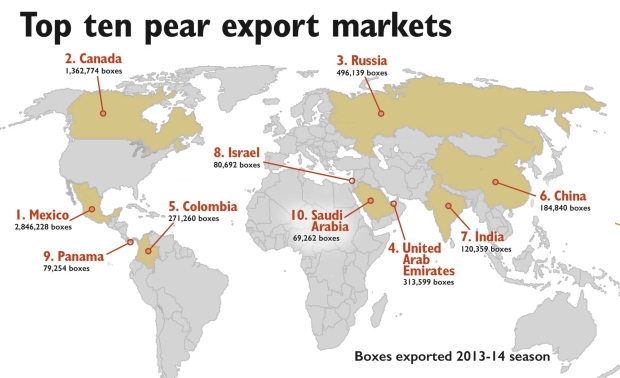
Boxes of pears exported from the U.S. in the 2013-14 season. Source: Washington State Tree Fruit Association
Northwest pear exports took a hit this season after a promising start.
Three things happened: Russia, the third most important market for U.S. pears, closed itself to U.S. pears; exports at West Coast ports slowed during a labor dispute; and the strong dollar made U.S. goods more expensive in overseas markets.
As of late May, fresh pear exports for the season totaled 5.7 million boxes, lagging about 13 percent behind the same period last year, according to statistics from the Washington State Tree Fruit Association.
Jeff Correa, director of export promotions at the Pear Bureau Northwest, said that early in the season pear exports seemed on track to beat last year’s record volumes. With port movement back to normal, the coming season’s export prospects will depend to a large extent on whether the Russian market is reopened.
Russia, which took almost 500,000 boxes of U.S. pears in the 2013-2014 season, banned imports of European and U.S. foods last August in retaliation against Western sanctions placed on Russia over its actions in the Ukraine.
Correa said Russia could decide to renew the one-year ban in August unless the U.S. and European Union sanctions are lifted. The ban has had a ripple effect, as European countries, such as Belgium, The Netherlands, Italy, Portugal, and Spain, which relied heavily on the Russian market, are also seeking alternative outlets for their pears, Correa reported at annual pear meetings in Portland, Oregon, in late May.
The ban has forced those countries to ramp up their efforts in markets outside Europe, such as Latin America, Brazil, Central America, the Middle East, and Asia.
Should the ban continue, Correa expects European producers to build on their momentum of this season and be more aggressive in those export markets with competitive pricing and promotions. The European Union is offering promotional support through a similar program to the federal Market Access Promotion. Belgium and the Netherlands have been doing in-store promotions of Conference pears in China.
Correa said even without the ban, he doubts Northwest pear exports to Russia will immediately rebound to 450,000 or 500,000 boxes. Factors that exporters will have to deal with include high value of the dollar (which is 40 percent higher against the ruble than a year ago), a credit crunch with importers, lower disposable income, and some anti-U.S. sentiment.
Top markets
The Pear Bureau set its export promotion budget for 2015-2016 at $5.7 million, of which $3 million will come from federal MAP funds. More than half the total funds are allocated to the top five export markets.
The top export market for U.S. pears is Mexico, which took almost 3 million boxes in the 2013-2014 season, followed by Canada, which took 1.5 million boxes, according to WSTFA figures. Other important markets include the United Arab Emirates (313,600 boxes), Colombia (271,160), China (184,840), and Brazil (165,434).
Correa said China is a growth market with a potential for 300,000 boxes annually, but exports this season were hampered by the port slow down.
The Pear Bureau is hoping to expand its efforts to new markets within China and promote additional varieties. Most pears shipped to China are Starkrimson and green and red d’Anjou. Correa sees potential for small volumes of Bartlett and Bosc.
India
Export growth in India has stalled, with exports to that country falling by 7 percent each of the past two years, but it still ranks in the top ten pear export markets, with around 113,000 boxes shipped this season. Factors at play include the high value of the dollar and efforts by fruit exporters to maximize apple sales into that market because of pressure to move the record crop.
“I think we may have taken a back seat with the pressure to move as many apples as possible,” Correa said.
The Pear Bureau will no longer have a presence in Malaysia, which Correa said has not been responding to promotions and activities. Consumers there seem to prefer crunchy Asian pears to the soft European varieties. Efforts will be directed instead to Indonesia and Vietnam where opportunities are thought to be better.
Brazil has banned pear imports from neighboring Argentina because of codling moth infestations. Correa said there are many abandoned orchards in Argentina’s Rio Negro and no agency is responsible for making sure trees are removed or sprayed to prevent the pest from infesting other orchards.
Brazil could reopen the market this July, which could result in a flood of cheap Packham pears from Argentina. Brazilian consumers prefer Bartlett pears, so the market for next season’s U.S. Bartletts should be good, but Argentine Packham pears could compete with U.S. d’Anjou pears in November and December, he said. •






Leave A Comment